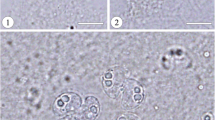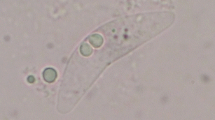Abstract
The myxosporean specimens were noted in grey gurnard Eutrigla gurnardus (L.) from the area near the Shetland Islands. The structure and dimensions of its vegetative stage differ from earlier descriptions. A sequence of small subunit ribosomal RNA gene obtained during the current study differs from other Ceratomyxa spp. available in GenBank. A phylogenetic position of parasite based on the 18S rDNA fragment was estimated. The proposed name for this myxosporean is Ceratomyxa gurnardi sp. n.





Similar content being viewed by others
References
Abdel-Ghaffar F, Ali MA, Al Quraishy S, Al Rasheid K, Al Farraj S, Abdel-Baki AS, Bashar AR (2008) Four new species of Ceratomyxa Telohan, 1892 (Myxozoa: Myxosporea: Ceratomyxidae) infecting the gallbladder of some Red Sea fishes. Parasitol Res 103:559–565. doi:10.1007/s00436-008-1010-8
Blanc M, Hureau JC (1973) Triglidae. In: Hureau JC, Monod T (eds) Check-list of the fishes of the North-Eastern Atlantic and of the Mediterranean, vol 1. Unesco, Paris, pp 586–590
Brickle P, Kalavati C, MacKenzie K (2001) Two new species of myxozoan parasites (Myxosporea, Bivalvulida) from toothfish Dissostichus eleginoides Smitt, 1898 (Pisces, Nototheniidae). Acta Parasitol 46(4):250–253
Cho JB, Know SR, Kim SK, Nam YK, Kim KI (2004) Ultrastructure and development of Ceratomyxa protopsettae Fujita, 1923 (Myxosporea) in the gallbladder of cultured olive flounder, Paralichthys olivaceus. Acta Protozool 43:241–250
Eiras JC (2006) Synopsis of the species of Ceratomyxa Thélohan, 1892 (Myxozoa: Myxosporea: Ceratomyxidae). Syst Parasitol 65(1):49–71
Felsenstein J (1985) Confidence limits on phylogenies: an approach using the bootstrap. Evolution 39:783–791
Floeter J, Kempf A, Vinther M, Schrum C, Temming A (2005) Grey gurnard (Eutrigla gurnadus) in the North Sea: an emerging key predator? Can J Fish Aquat Sci 62:1853–1864. doi:10.1139/f05-108
Froese R, Pauly D (2011) Fish base. World Wide Web electronic publication. www.fishbase.org. Accessed 17 January 2012
Gaevskaâ AV, Kovaleva AA (1979) New and rarely found myxosporidian species of fishes from the Celtic Sea. Parasitologiâ 13:159–165
Gunter N (2009) Relatedness, host specificity and richness of the genus Ceratomyxa (Myxozoa: Myxosporea) in teleost fishes. Dissertation, School of Chemistry & Molecular Bioscience, The University of Queensland
Gunter NL, Whipps CM, Adlard RD (2009) Ceratomyxa (Myxozoa: Bivalvulida): robust taxon or genus of convenience? Int J Parasitol 39:1395–1405. doi:10.1016/j.ijpara.2009.04.008
Heessen HJL, Daan N (1994) Distribution and abundance of grey gurnard (Eutrigla gurnardus) in the North Sea. International Council for the Exploration of the Sea Council Meeting 1994/O: 3
Heiniger H, Gunter NL, Adlard RD (2008) Relationship between four novel ceratomyxid parasites from the gall bladder of labrid fishes from Heron Island, Queensland, Australia. Parasitol Int 57:158–165
Kabata Z (1962) Five new species of myxosporidia from marine fishes. Parasitology 52:177–186
Kent ML, Khattra J, Hedrick RP, Devlin RH (2000) Tetracapsula renicola n. sp. (Myxozoa: Saccosporidae); the PKX myxozoan—the cause of proliferative kidney disease of salmonid fishes. J Parasitol 86:103–111
Kent ML, Andree KB, Bartholomiew JL, El Matbouli M, Desser SS, Devlin RH, Feist SW, Hedrick RP, Hoffmann RW, Khattra J, Hallett SL, Lester RJG, Longshaw M, Palenzeula O, Siddali ME, Xiao C (2001) Recent advances in our knowledge of the Myxozoa. J Eukaryot Microbiol 48:395–413. doi:10.1111/j.1550-7408.2001.tb00173.x
Køie M, Karksbakk E, Nylund A (2007) Parvicapsula bicornis n. sp. and Parvicapsula limandae n. sp. (Myxozoa, Parvicapsulidae) in Pleuronectidae (Teleostei, Heterosomata) from Denmark. Dao 76:123–129. doi:10.3354/dao076123
Landsberg JH (1993) Myxosporean parasites of common snook in Florida. J Aquat Anim Health 5:102–109
Lom J, Arthur JR (1989) A guideline for the preparation of species description in Myxosporea. J Fish Dis 12:151–156
Lom J, Dykova E (2006) Myxidian genera: definition and notes on taxonomy, life-cycle terminology and pathogenic species. Folia Parasit 53:1–36
Lubat J, Radujkovic B, Marques A, Bouix G (1989) Parasites des poisson marins de Montenegro. Acta Adriat 30:31–50
Saitou N, Nei M (1987) The neighbor-joining method: a new method for reconstructing phylogenetic trees. Mol Biol Evol 4:406–425
Sitjà-Bobadilla A, Palenzuela O, Alvarez-Pellitero P (1995) Ceratomyxa sparusaurati n.sp (Myxosporea, Bivalvulida), a new parasite from cultured gilthead sea bream (Sparus aurata L.) (Teleostei, Sparidae)—light and electron microscopic description. J Eucaryot Microbiol 42:529–539. doi:10.1111/j.1550-7408.1995.tb05901.x
Tamura K, Nei M, Kumar S (2004) Prospects for inferring very large phylogenies by using the neighbor-joining method. PNAS 101:11030–11035. doi:10.1073/pnas.0404206101
Tamura K, Peterson D, Peterson N, Stecher G, Nei M, Kumar S (2011) MEGA5: molecular evolutionary genetics analysis using maximum likelihood, evolutionary distance, and maximum parsimony methods. Mol Biol Evol 28(10):2731–2739. doi:10.1093/molbev/msr121
Thompson JD, Higgins DG, Gibson TJ (1994) Clustal W: improving the sensitivity of progressive multiple sequence alignment through sequence weighting, position-specific gap penalties and weight matrix choice. Nucleic Acids Res 22:4673–4680. doi:10.1093/nar/22.22.4673
Acknowledgments
The authors would like to thank Mr. W. Szaszkiewicz for providing the specimens of E. gurnardus. Thanks are also due to Dr. J. Szulc and Mr. M. Więcaszek for technical support.
Author information
Authors and Affiliations
Corresponding author
Rights and permissions
About this article
Cite this article
Sobecka, E., Szostakowska, B., Ziętara, M.S. et al. Morphological and molecular characterization of Ceratomyxa gurnardi sp. n. (Myxozoa: Ceratomyxidae) infecting the gallbladder of the grey gurnard Eutrigla gurnardus (L.) (Scorpaeniformes, Triglidae). Parasitol Res 112, 731–735 (2013). https://doi.org/10.1007/s00436-012-3193-2
Received:
Accepted:
Published:
Issue Date:
DOI: https://doi.org/10.1007/s00436-012-3193-2




